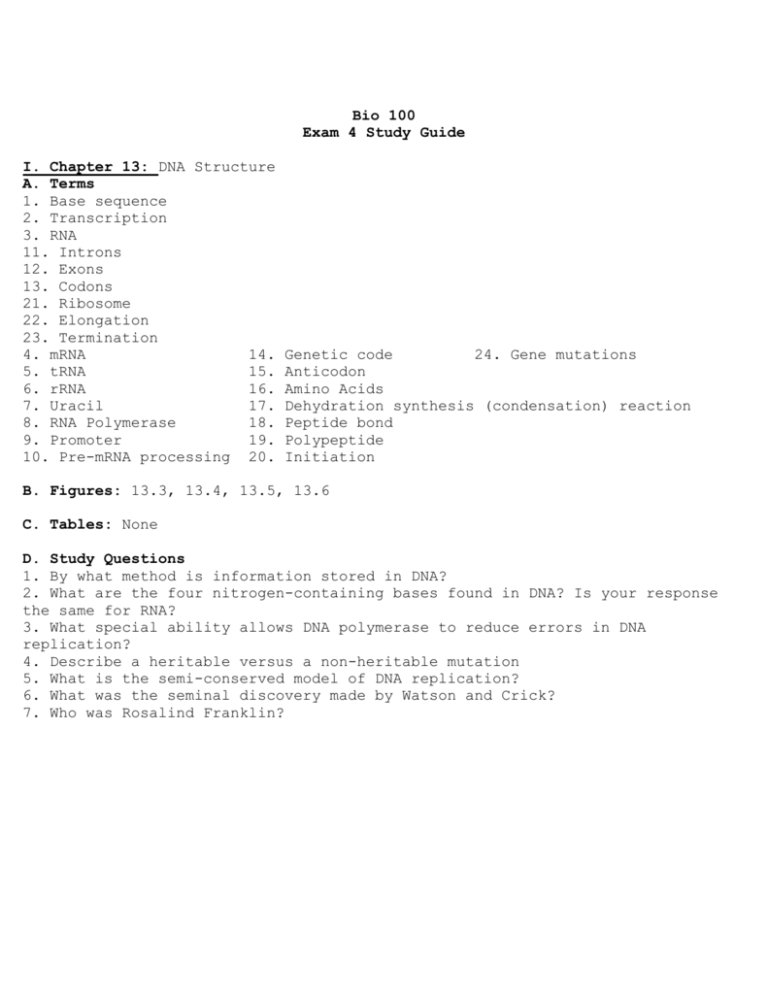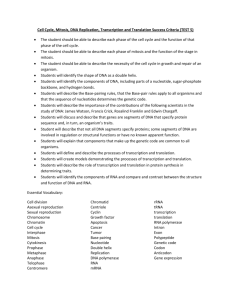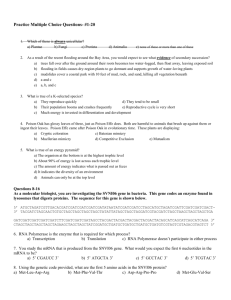Exam 4 Study Guide - philipdarrenjones.com
advertisement

Bio 100 Exam 4 Study Guide I. Chapter 13: DNA Structure A. Terms 1. Base sequence 2. Transcription 3. RNA 11. Introns 12. Exons 13. Codons 21. Ribosome 22. Elongation 23. Termination 4. mRNA 14. 5. tRNA 15. 6. rRNA 16. 7. Uracil 17. 8. RNA Polymerase 18. 9. Promoter 19. 10. Pre-mRNA processing 20. Genetic code 24. Gene mutations Anticodon Amino Acids Dehydration synthesis (condensation) reaction Peptide bond Polypeptide Initiation B. Figures: 13.3, 13.4, 13.5, 13.6 C. Tables: None D. Study Questions 1. By what method is information stored in DNA? 2. What are the four nitrogen-containing bases found in DNA? Is your response the same for RNA? 3. What special ability allows DNA polymerase to reduce errors in DNA replication? 4. Describe a heritable versus a non-heritable mutation 5. What is the semi-conserved model of DNA replication? 6. What was the seminal discovery made by Watson and Crick? 7. Who was Rosalind Franklin? I. Chapter 14: How Proteins Are Made – Genetic Transcription, Translation, and Regulation A. Terms 1. Base Sequence 11. Introns 21. Elongation 2. Transcription 12. Exons 22. Termination 3. RNA 13. Codons 23. Translation 4. mRNA 14. Genetic Code 24. Gene 5. tRNA 15. Anticodon 6. rRNA 16. Amino Acids 7. Uracil 17. Peptide bond 8. RNA Polymerase 18. Polypeptide 9. Promoter 19. Initiation 10. Pre-mRNA processing 20. Ribosome B. Figures: 14.1, 14.2, 14.3, 14.4, 14.5, 14.6, 14.7, 14.8, 14.9, 14.10, 14.11, 14.13, 14.14, 14.15 C. Tables: 14.2 D. Study Questions 1. By what method is information stored in DNA (again?!)? 2. What is transcription? Where does it occur in eukaryotic cells? 12. What acts as the template for transcription? 13. What are the four nitrogen-containing bases found in DNA? Is your response the same for RNA? 14. What molecule is responsible for carrying out transcription? 15. What is/are the name(s) for the product(s) of transcription? 16. List the three types of RNA and give a brief description of each. 17. What is the function of the promoter region? Is the promoter found on the DNA or RNA? 18. Describe the process of pre-mRNA processing. Your response should include the following terms: intron, exon, RNA polymerase, and mature mRNA transcript. 19. Which types of RNA listed in #7 can be translated? 20. What is the template for translation? 21. What is the product of translation? 22. What is the function of a codon and how does it involve the genetic code? 23. What is the amino acid that corresponds to the following codon: UGG? 24. What is the function of the ribosome? 25. What is the function of the tRNA? How is the anti-codon important to this function? 26. Briefly describe the events during the following stages of translation: initiation, elongation, and termination. 27. How does the ribosome “know” when translation of a particular mRNA is completed? 28. How are the following terms interrelated: polypeptide, amino acids, and dehydration synthesis (condensation) reaction? I. Chapter 15: Biotechnology A. Terms: 1. biotechnology 2. blastocyst 3. clone 4. embryonic stem cells 5. plasmid 6. polymerase chain reaction 13. transgenic organism 7. Recombinant DNA 8. Reproductive cloning 9. Restriction enzyme 10. Somatic cell nuclear transfer 11. Therapeutic cloning 12. transformation B. Figures: 15.3, 15.4, 15.5, 15.6, 15.8, 15.9, 15.10 C. Tables: None D. Study Questions: 1. What do restriction enzymes do? How do they work? 2. What are sticky ends? 3. What is a transgenic organism? 4. What is the process of genetic exchange performed by bacteria? 5. Extra chromosomal rings of bacterial DNA often used in cloning are called what? 6. Describe the process of building recombinant DNA. 7. Using recombinant DNA, how are human proteins produced by bacteria? 8. Why are genetically modified organisms controversial? 9. Describe the process of somatic cell nuclear transfer. 10. What is reproductive cloning? 11. What is the purpose of the polymerase chain reaction (PCR)? 12. What is the difference between embryonic stem cells and adult stem cells? 13. From where are embryonic stem cells obtained? 14. With regard to stem cells what does pluripotency mean? 15. What is cellular commitment? I. Chapter 16: Introduction to Evolution A. Terms 1. Evolution 12. Genetic Equilibrium 2. Biogeography 13. Mutation Rate 3. Comparative Morphology 14. Natural Selection 4. Fossils 15. Hardy-Weinberg Rule 5. Charles Darwin 16. Fitness 6. Alfred Wallace 17. Directional Selection 7. On the Origin of Species 18. Stabilizing Selection 8. Population 19. Disruptive Selection 9. Polymorphism 20. Sexual Selection 10. Gene Pool 21. Balanced Polymorphism 11. Allele Frequencies 22. Gene Flow 23. 24. 25. 26. Genetic Drift Bottleneck Founder Effect Fixation B. Figures: 16.3, 16.9, 16.11, 16.14 C. Tables: None D. Study Questions: 1. What was Darwins core principle of evolution? 2. Describe natural selection. 3. Observations from what regions were the most influential to Charles Darwins development of evolutionary theory? 4. What influence did Charles Lyell have on Darwin? 5. Who was Alfred Russel Wallace and what did he do? 6. What are the six lines of evidence that are in support of the theory of evolution? 7. How does DNA nucleotide base difference effect degree of relation between species? I. Chapter 17: The Means of Evolution -Microevolution A. Terms 1. Species 2. Gene Pool 3. Microevolution 4. Macroevolution 5. Evolution 6. Mutation 7. Gene Flow 8. Population 9. Genetic Drift 10. Bottleneck Effect 11. 12. 13. 14. 15. 16. 17. 18. 19. 20. Founder Effect 21. Polygenic Nonrandom Mating 22. Allele Frequency Assortive Mating Sexual Selection Natural Selection Adaptation Directional Selection Stabilizing Selection Disruptive Selection Fitness B. Figures: 17.1, 17.2, 17.3, 17.4, 17.5, 17.6, 17.9, 17.10, 17.11, 17.12 C. Tables: 17.1 D. Study Questions 1. What does the term “evolution” mean with respect to allele frequencies within a population? 2. What are the five sources of genetic variation between generations of a sexually reproducing population? 3. How would a change in each of the conditions (a violation of them) result in a change in allele frequencies? 4. What is the relationship between changing allele frequencies in a population and microevolution? 5. Are mutations always “bad”? How are lethal mutations eliminated from a population? 6. What is the fate of neutral and beneficial mutations with respect to their frequency in a population? 7. What determines whether an individual in a population is considered “fit”? Can an individual be fit in one circumstance but less fit in another? 8. How does the process of natural selection affect those individuals who are “more fit”? “Less fit”? 9. Be able to distinguish between directional, disruptive, and stabilizing selection. Give real life examples of each. 10. How has sexual selection created sexual dimorphism in some species? 11. How can the random process of genetic drift result in the complete loss or fixation of an allele in a population? 12. State real life examples of a bottleneck and the founder effect and explain how these result in reduced genetic variability in the population.








